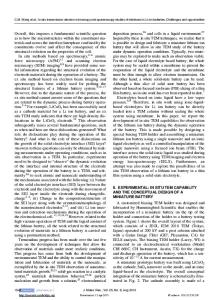Solid Electrolyte Interfaces and Interphases in Lithium Batteries: In Situ Studies Using Nonlinear Optical Probes
- PDF / 13,254,648 Bytes
- 6 Pages / 612 x 792 pts (letter) Page_size
- 2 Downloads / 348 Views
Solid Electrolyte Interfaces and Interphases in Lithium Batteries: In Situ Studies Using Nonlinear Optical Probes Prabuddha Mukherjee, Alexei Lagutchev and Dana D Dlott School of Chemical Sciences, University of Illinois at Urbana Champaign, Urbana, IL 61801 ABSTRACT Solid-electrolyte interphase (SEI) regions play a critical role in stabilizing lithium batteries, but little is known about the detailed mechanism of growth and formation. We have developed a novel method for in situ study of the interfacial regions of SEI layers, using an interface-selective nonlinear vibrational spectroscopy method termed femtosecond broadband multiplex vibrational sum-frequency generation spectroscopy (SFG) and a lithium battery electrochemical cell with optical access. SFG has high sensitivity and high selectivity needed to study vibrational transitions of molecular species during the SEI growth. SFG is most sensitive to interfacial regions, so with SFG we ignore the bulk electrolyte and focus on interface regions just a few molecules thick. During SEI growth there are two such interfaces, the electrode-SEI interface and the electrolyte SEI interface. We will present results obtained using a lithium battery and model materials relevant to Li batteries, where during successive cycles of charge and discharge we selectively probe the structural evolution of these two interfaces on Au, Cu and carbon. INTRODUCTION We report here the first nonlinear vibrational spectroscopic studies of a solid electrolyte interphase (SEI) during successive charge/discharge cycles, in a model system relevant to the lithium-ion battery. SEI develops on Li battery anodes due to the reduction of the electrolyte [1]. SEI has been studied extensively over the last decade [2] but a detailed understanding of its formation and functioning requires additional investigation. The growth of SEI is potential dependent as shown in Fig. 1. Prior to potential cycling (2.0 V, Fig. 1a) the electrode surface is covered by electrolyte. As the potential is lowered to 0.2 V (Fig. 1b), the electrolyte/solvent reduces and forms a SEI. During the formation of SEI, two interfaces appear, an electrode–SEI interface (electrode interface) and SEI-electrolyte interface (electrolyte interface) [3].
Figure 1. When the potential becomes reducing, an SEI develops, creating two new interfaces that can be probed by SFG. A schematic of the spectroelectrochemical cell is shown at right.
Interfacial selectivity and sensitivity of SFG spectroscopy arises from the fact that it measures the second order susceptibility χ2 that vanishes in centrosymmetric bulk media [3]. In the spectra displayed here we suppressed the non-resonant contribution from the electrode using methods described elsewhere [4]. Thus we directly measure the response from the surface molecular layer (ranges from one to several layers) disregarding any influence from the bulk. Here, we present data on a model system based on work by the Ross group [5] in Berkeley. The electrolyte is ethylene carbonate (EC) in tetrahydrofuran (
Data Loading...










